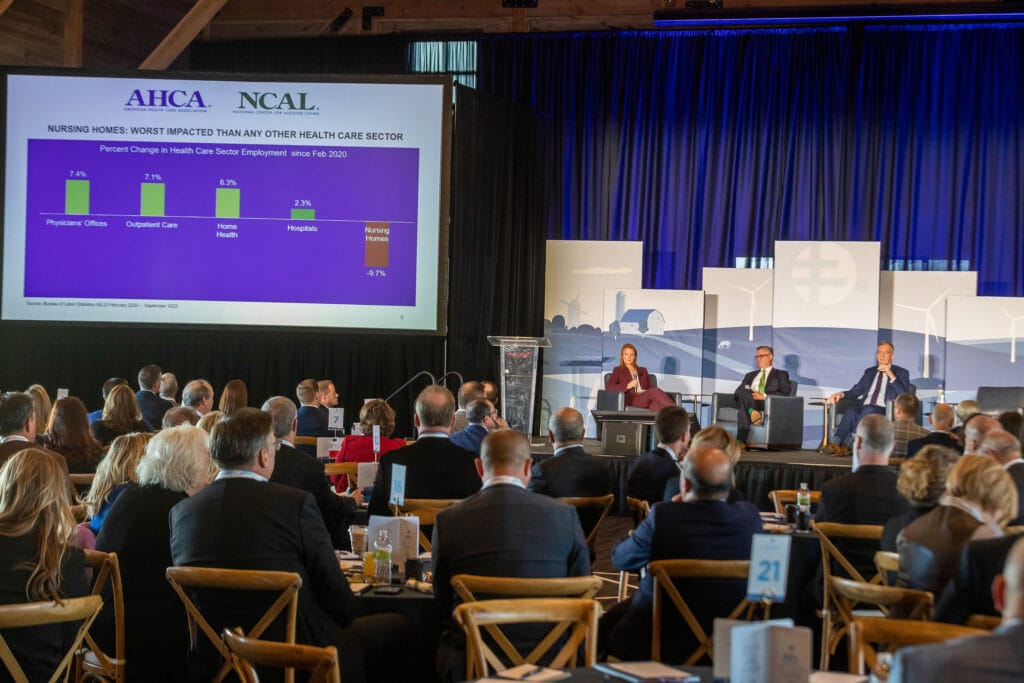
Long-term care industry advocates pulled no pessimistic punches Wednesday when asked about likely outcomes facing rural operators if the Centers for Medicare & Medicaid Services’ proposed minimum staffing mandate becomes a rule.
But the increased potential to collaborate on solutions across the healthcare sector may bring relief, they said while taking part at the Summit on the Future of Rural Health Care in Sioux Falls, SD.
With vast discrepancies in access to care between rural and urban communities and ongoing staffing shortages, CMS’ mandate as proposed is impossible to achieve, and “literally a death sentence for nursing homes in rural areas,” said Mark Parkinson, president & CEO of the American Health Care Association/National Center for Assisted Living.
“The administration is very well intentioned, but unfortunately the minimum staffing proposal that they have announced doesn’t recognize the reality, … that the challenge of the 21st century is how do we take care of more people with the same or fewer workers,” he said during the Sanford Health-sponsored event. Sanford is the parent company of Good Samaritan Society, the nation’s largest non-profit provider of skilled nursing.
“This is a disaster,” added Alan Morgan, CEO of the National Rural Health Association, who joined Parkinson as a featured speaker. “The impact that it has, potentially, on rural communities cannot be understated.”
Under the proposed staffing mandate, facilities would have at least three years (or five years, in the case of rural facilities) to provide at least 0.55 hours per day by a registered nurse and 2.45 hours by a nurse aide.
It’s a one-size-fits-all solution for a diverse industry already under severe cost and staff pressures, said Clifton Porter, senior vice president of government affairs of AHCA/NCAL, in a separate session Wednesday.
“I’ve never seen a proposed rule be more out of touch with the realities of delivering healthcare as this one,” Porter said, referring to variables of facility size, number of patients and types of patients served.
“You’re putting out a policy when there is no supply to fill it,” he added. “It doesn’t affect only nursing homes. What impacts one component of the healthcare system impacts us all.”
Rural hospital fallout
The effects of the long-term care sector’s staffing problems are being felt acutely across the healthcare system, namely in hospital discharge backups — and most acutely in rural communities, the speakers said.
Since the pandemic’s start, about 250,000 nursing home staff have been lost due to attrition and 600 nursing homes have closed across the United States, Parkinson said. Facility losses in rural areas are double those in urban areas, he added. The CMS staffing mandate would require US nursing homes to hire an additional 22,000 registered nurses and another 80,000 certified nurse aides, he noted.
Meanwhile, nursing home shortages are translating to higher cost burdens for rural hospitals — nearly $1,000 for each patient that can’t be discharged when scheduled, added Morgan. Rural hospitals must also compete for the same staff as nursing homes, he noted.
“It makes the potential problem of keeping nursing homes open extremely problematic and is making it even more difficult on the financial end to keep these rural hospitals open,” Morgan said.
“This is a problem that we are all in together,” Parkinson agreed.

CMS so far has not budged on its plans to make the proposal a final rule, despite so far receiving 8,800 comments from AHCA/NCAL members detailing the pain the mandate would bring to already understaffed facilities, Parkinson noted. CMS officials have called the proposal “balanced and achievable.”
But Parkinson said the penalties are not simply a notation affecting a facility’s Five-Star rating. The penalties are fines, potential stoppage of services and, possibly, mass closures.
“The policy is really extreme, and we are hopeful that the administration will change it before it becomes a final rule, to make it something that can actually work,” he said. “But what we really need is thought leadership from the administration.”
Potential solutions
There is an upside to this looming staff shortage issue in the potential for interconnectivity and collaboration, Parkinson and Morgan said in their session, which was titled “Sync or swim? Aligning workforce solutions to support care across the continuum” and moderated by McKnight’s Long-Term Care News Senior Editor Kimberly Marselas.
“What you are seeing in the data is when you can have nursing homes, community health centers, rural health clinics, hospitals working together to address this you have positive movement going forward,” Morgan noted. He foresees the partnering of community health workers with primary care, and legislation that would extend visas for immigrant physicians as keys to addressing the staffing problem in rural locales.
CMS’ proposed rule “demonstrates a lack of understanding” by the administration about rural health, he said. Rural communities are innovation hubs, and the birthplace of the patient-centered medical home concept, which supports team-based care, he noted. He supports working with the administration “to make sure that we have a correction.”
Parkinson said AHCA/NCAL is backing an improved federal pipeline for immigrant nurses, and is bullish on telehealth use for mitigating the issue of RN shortages.
“The data are very clear that if you have more RN time in your buildings, you’re going to get better outcomes,” he said. “But in parts of the country where we can’t physically get an RN in, particularly on the evening and night shifts, we can have them available, as well as physicians available through the use of telehealth and telemedicine. I think that’s a very exciting opportunity.”
Evidence that some rural operators are taking a leap of faith and developing their own managed care plans is another reason for optimism about the future, he added.
“It’s working even in very rural areas with a very high Medicaid population, he said. “I think it’s a part of the answer for how we keep all nursing homes viable.”
Relationships between different provider types and participation in value-based purchasing programs also hold promise for staffing strategies, Parkinson added. He used the 2019 merger of Sanford and Good Samaritan Society as an example of a mutually beneficial relationship between a multi-state hospital system and a large senior care services operator.
“The more integrative you are … you’re going to create efficiencies,” he said.




